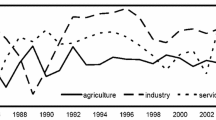Abstract.
The paper presents an empirical analysis on the role played by urbanisation and localisation economies on factor productivity of firms. A vast literature exists on this issue, conceptually presenting reasons supporting either industry size or city size as sources of external advantages. In general, the empirical analyses are based on the estimates of aggregate city or industry production functions; the limited hypotheses characterising these studies have suggested to test another methodology, based on the estimate of a production function at the firm level, and calculate how factor productivity changes according to different degrees of urbanisation and localisation economies. The methodology is applied to firms chosen in the high-tech sector, which demonstrates a high spatial concentration in particular areas of the Metropolitan Area of Milan. The result is that factor productivity is influenced by both urbanisation and localisation economies, but the latter show an increasing positive effect on factor productivity. Moreover, the size of firms plays an important role in defining the impact of urbanisation and localisation economies on firms' outcome.
Similar content being viewed by others
Author information
Authors and Affiliations
Rights and permissions
About this article
Cite this article
Capello, R. Entrepreneurship and spatial externalities: Theory and measurement. Ann Reg Sci 36, 387–402 (2002). https://doi.org/10.1007/s001680200106
Issue Date:
DOI: https://doi.org/10.1007/s001680200106




